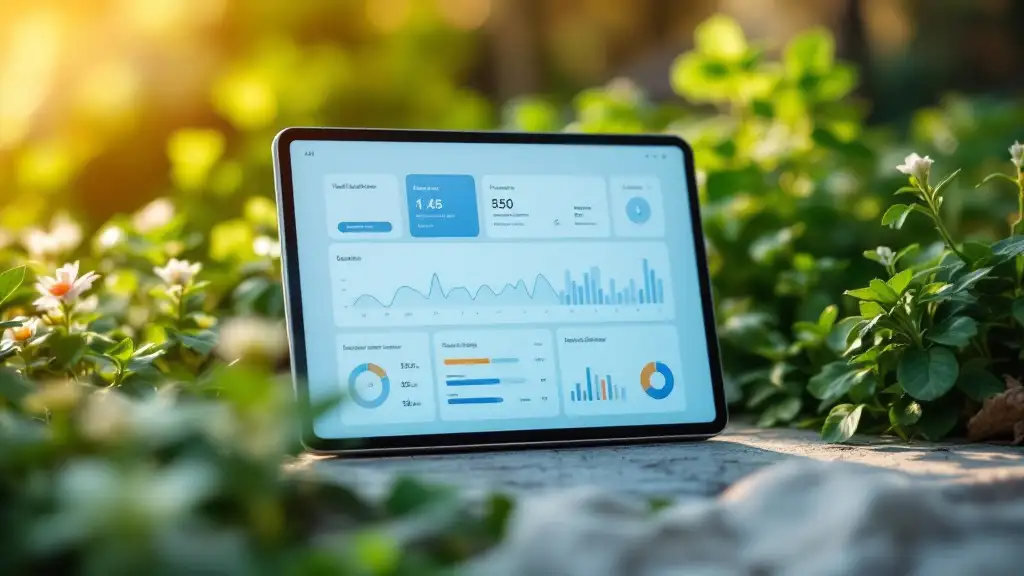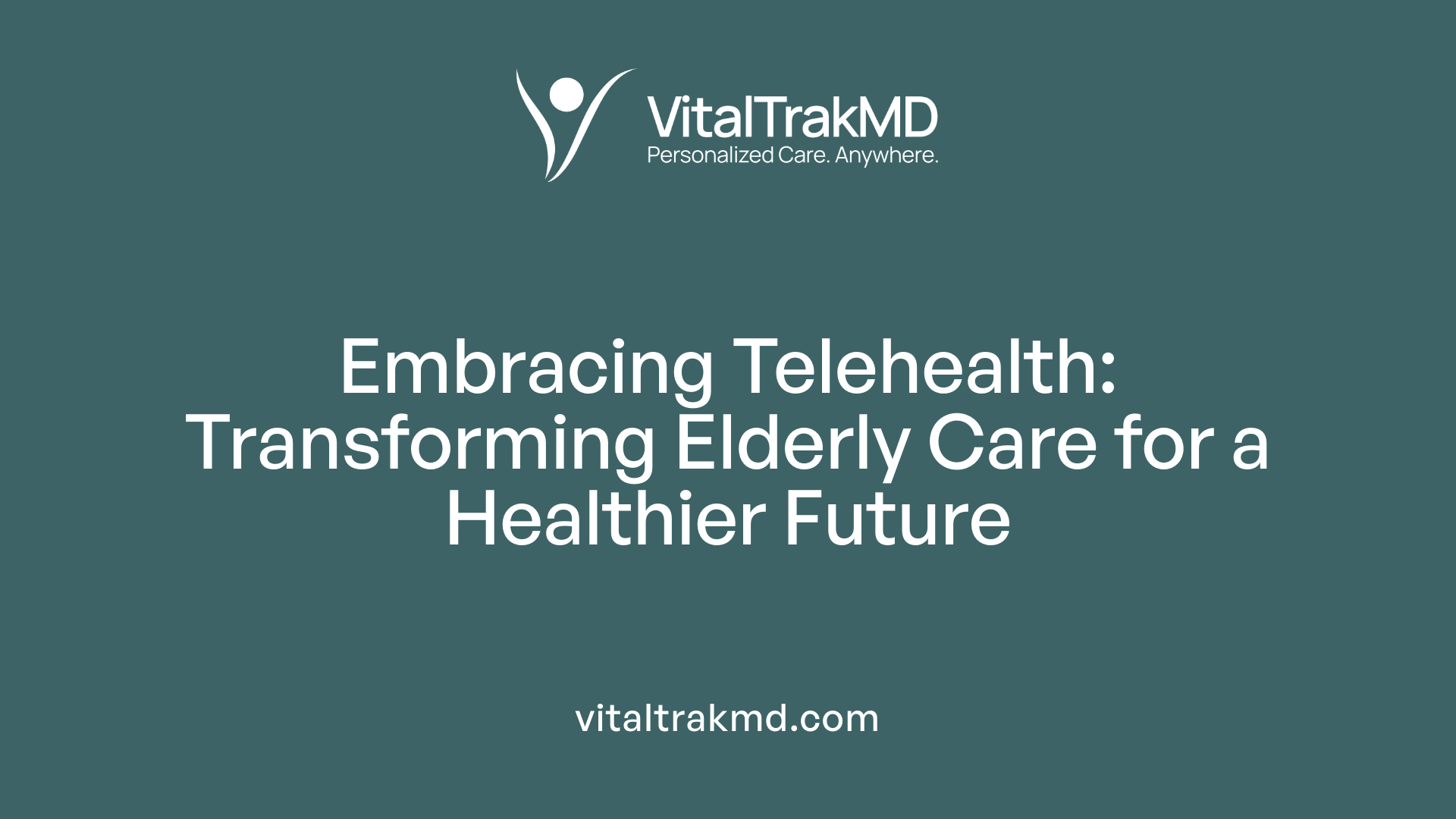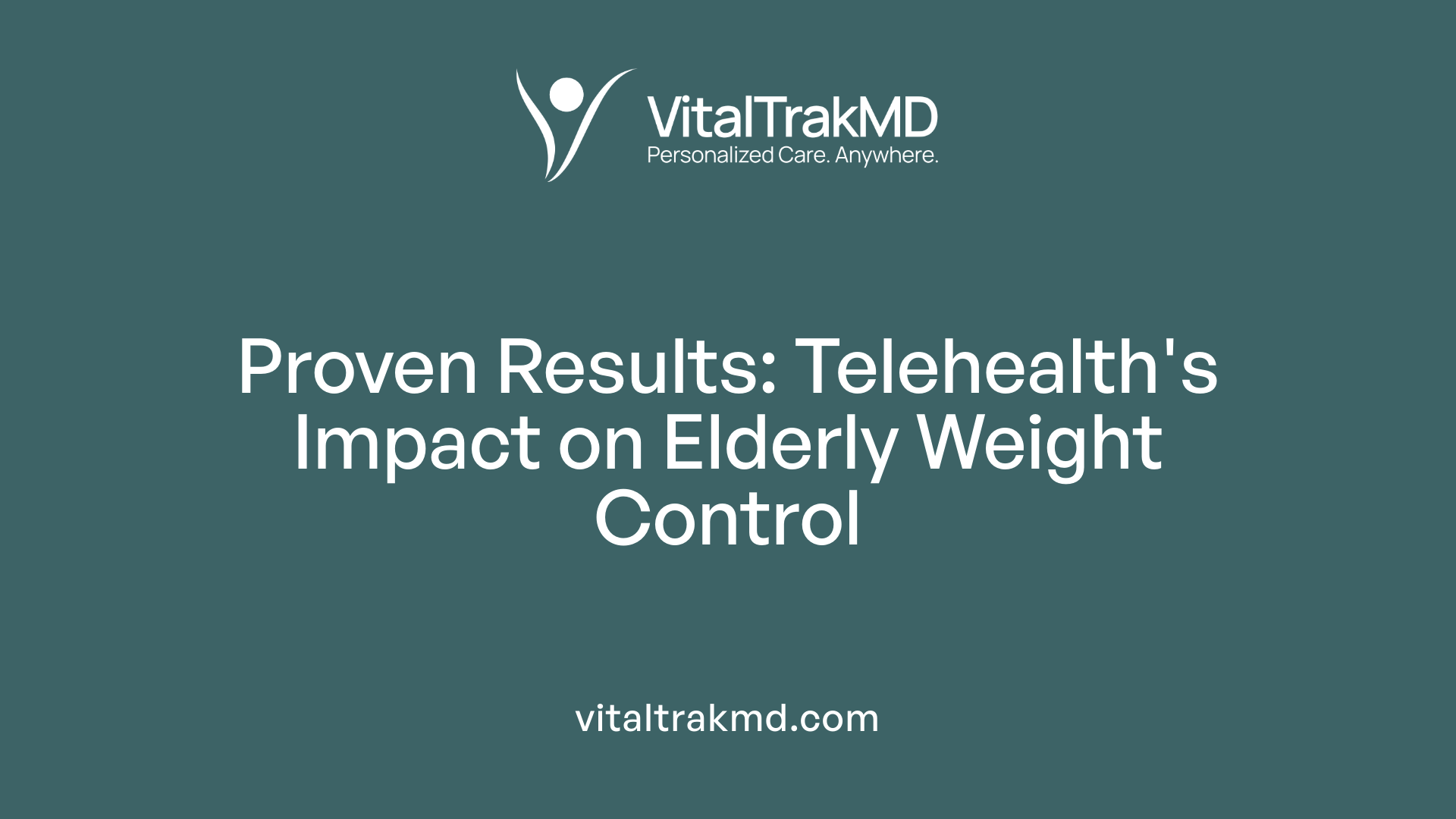The Role of Telehealth in Long-Term Weight Maintenance for Seniors

Harnessing Telehealth for Sustained Weight Management in Seniors
Telehealth has emerged as a vital tool in addressing the complex challenge of long-term weight maintenance among seniors. By leveraging digital health technologies, remote interventions, and personalized strategies, telehealth offers promising solutions to improve health outcomes, especially in underserved and rural populations. This article explores the multifaceted role of telehealth, examining its effectiveness, methodologies, benefits, challenges, and the future potential in supporting elderly weight management.
Overview of Telehealth and Its Growing Role in Elderly Care

What is the role of telehealth in supporting long-term weight maintenance for seniors?
Telehealth has become an increasingly vital tool for helping seniors maintain a healthy weight over the long term. It offers an accessible, personalized approach to care by enabling virtual interactions with healthcare professionals like dietitians, physicians, and psychologists. This means seniors can receive regular counseling and support without the need for travel or in-person visits.
Through modalities such as videoconferencing, phone calls, text messages, and online chats, telehealth facilitates continuous engagement. It allows healthcare providers to deliver dietary guidance, physical activity plans, and behavioral strategies such as self-monitoring and relapse prevention.
Research shows that these interventions can lead to meaningful weight loss and better weight maintenance, comparable to traditional face-to-face programs. For example, studies using phone-based counseling in rural communities have demonstrated that personalized telehealth support helps prevent weight regain and encourages the achievement of significant weight loss targets, such as at least 10% of initial body weight.
Moreover, telehealth supports the management of obesity-related chronic conditions like hypertension and diabetes, making it a comprehensive approach to health for seniors. For those living in rural or underserved areas, where access to healthcare professionals might be limited, telehealth removes barriers to consistent care.
Overall, telehealth enhances the accessibility, personalization, and continuity of obesity treatment. It promotes sustained engagement and helps peers stick to their weight management goals, fostering better health outcomes over the long haul for elderly populations.
Effectiveness of Telehealth in Elderly Weight Management

How effective are telehealth interventions in managing weight among elderly populations?
Telehealth strategies have shown promising results in helping older adults manage their weight effectively. Multiple studies indicate that remote interventions, including weekly counseling sessions, educational modules, and web-based programs, can lead to meaningful weight loss and health improvements.
Common telehealth methods involve various communication tools such as videoconferencing, phone calls, text messaging, and online chats. These modalities make it possible to deliver personalized guidance on nutrition, physical activity, and relapse prevention. Features like self-monitoring of weight, diet, and activity play a crucial role in fostering accountability and tracking progress.
Evidence from research suggests that these interventions can yield outcomes comparable to, or even exceeding, traditional in-person treatments. Some studies report greater weight loss and higher attendance rates in telehealth groups. For instance, a rural community-focused trial demonstrated that long-term telehealth support led to a smaller mean weight regain (2.3 kg versus 4.1 kg in controls) and increased the likelihood of participants achieving at least a 10% reduction in body weight.
While the current data are encouraging, more research is needed to assess the sustainability of weight management through telehealth over extended periods. Especially for seniors, further investigation is necessary to understand how digital literacy and technology access influence outcomes. Despite some limitations, existing evidence affirms that telehealth can be a practical, safe, and effective approach for elderly individuals, addressing critical barriers such as mobility issues and geographic isolation.
Expanding access and improving health outcomes in diverse populations
Telehealth's potential to reach underserved and high-risk groups, including seniors, rural dwellers, and ethnic minorities, underscores its significance in future obesity care strategies. The use of adaptable digital platforms, supported by systems like the US Cooperative Extension, offers scalable solutions capable of overcoming transportation barriers and integrating personalized care.
In conclusion, while ongoing studies focus on maximizing long-term weight maintenance and understanding specific demographic effects, current evidence affirms telehealth’s role as a valuable and effective tool in managing weight among the elderly, fostering healthier aging populations.
Methods and Strategies in Telehealth for Elder Weight Maintenance

What methods and strategies are used in telehealth to support weight maintenance in older adults?
Telehealth offers various ways to help older adults maintain their weight effectively. One key approach is remote dietary counseling, where dietitians or healthcare professionals provide personalized nutrition advice through virtual means.
In addition, virtual exercise programs are incorporated to promote physical activity tailored to the individual’s health status and mobility levels. These programs can include live video classes or recorded sessions accessible at any time, encouraging consistent exercise habits.
Digital monitoring tools play a significant role by enabling self-monitoring of weight, diet, and physical activity. Participants can track their progress using apps, wearable devices, and online platforms, which provide real-time feedback and support.
Modalities such as videoconferencing, online chats, text messages, and phone calls facilitate ongoing interaction between healthcare providers and older adults. Videoconferencing, in particular, can emulate in-person interactions, helping to forge stronger interpersonal connections that can positively influence engagement and outcomes.
Healthcare professionals—such as dietitians, physicians, psychologists, and exercise physiologists—deliver tailored content with a focus on portion control, increasing physical activity, relapse prevention, and maintaining adherence to caloric and dietary goals.
Furthermore, telehealth can support remote assessments, offer nutrition education, and provide reminders for healthy behaviors like hydration and medication adherence. These interventions are adaptable and can be customized based on individual needs.
Evidence from recent research indicates that personalized telehealth interactions, especially those involving individual counseling, lead to better long-term weight maintenance in older adults. Continued studies aim to develop culturally sensitive and sustainable telehealth strategies that address the unique challenges faced by this population, including multiple chronic conditions.
Overall, telehealth approaches for elderly weight management capitalize on technology and personalized support to improve health outcomes, increase access to care, and promote sustainable lifestyle changes.
Benefits and Challenges of Telehealth for Seniors' Long-Term Weight Control

What are the challenges and benefits of using telehealth for long-term weight control in seniors?
Telehealth offers numerous advantages for supporting seniors in long-term weight management. One of the main benefits is increased access to healthcare services, especially for those living in remote or underserved areas. Seniors can receive personalized care through virtual consultations, coaching, and continuous support without the need to travel to clinics. This convenience can greatly enhance adherence to weight loss programs.
Another benefit is the ability to deliver tailored dietary and behavioral interventions through digital means. Programs can incorporate tools like remote monitoring devices that track weight, physical activity, and other health metrics in real-time. These features promote ongoing motivation and accountability, which are crucial for sustaining weight loss over time.
Furthermore, telehealth enables integrated management of chronic conditions often found in older adults, such as diabetes, hypertension, and arthritis. Coordinated care through virtual platforms can improve health outcomes and reduce complications, facilitating better overall weight control.
Cost-effectiveness is another notable advantage. Telehealth interventions often cost less than traditional face-to-face programs, making long-term support more feasible and sustainable. With appropriate digital engagement, seniors can also benefit from regular feedback and timely interventions to prevent setbacks.
Despite these advantages, there are notable challenges. Technological barriers are common among older adults, including difficulties with digital literacy and access to suitable devices or reliable internet. Many seniors may find using new technologies intimidating or confusing, which can hinder their participation.
Infrastructure and resource limitations also pose challenges. Ensuring all seniors have the necessary tools and support to use telehealth platforms effectively is essential. Customizable user interfaces, simplified devices, and digital literacy training are critical to overcoming these barriers.
In conclusion, while telehealth offers promising solutions for long-term weight management in seniors by providing continuous, personalized care that can improve health outcomes, overcoming technological and infrastructural barriers is vital to maximize its potential benefits.
Digital Technologies in Elderly Obesity Management

How do digital health technologies and telehealth applications aid in managing obesity in seniors?
Digital health technologies, including mobile health (mHealth) apps, wearables, and remote assessment tools, have revolutionized the way obesity is managed among elderly populations. These tools facilitate the remote monitoring of essential health metrics such as physical activity levels, sleep patterns, body weight, and vital signs like blood pressure and heart rate. This continuous monitoring allows healthcare providers to tailor personalized interventions, adjusting dietary plans and physical activity recommendations based on real-time data.
Telehealth applications extend the reach of healthcare services by connecting seniors with dietitians, physicians, and psychologists without the need for physical visits. This is particularly vital for those in rural or underserved areas, where healthcare resources may be limited. Furthermore, digital platforms support ongoing emotional and psychological encouragement through online coaching sessions, social communities, and interactions with chatbots powered by AI. These features foster sustained behavioral changes necessary for effective weight loss and maintenance.
A comprehensive digital ecosystem, integrating these various technologies, encourages adherence to treatment plans by providing reminders, motivational feedback, and educational content. This approach not only promotes physical health but also addresses mental well-being, which is crucial for long-term weight management.
Additionally, digital tools aid in medication adherence by sending reminders and recording medication intake, ensuring optimal treatment outcomes. The collection of real-world data through these technologies allows for ongoing evaluation and optimization of treatment strategies, contributing to a more personalized and effective obesity management plan.
While digital innovations offer promising benefits, it is essential to recognize the challenges, such as ensuring digital literacy among seniors. Efforts must be made to bridge the digital divide, providing training and resources to make these technologies accessible and user-friendly for all older adults. By doing so, digital health applications can help address existing health inequalities and make obesity management more equitable.
In summary, the integration of digital health technologies and telehealth in elderly obesity care supports remote monitoring, personalized interventions, medication adherence, and continuous data collection. These advancements foster more effective, accessible, and sustained weight management strategies tailored to the unique needs of seniors.
Research and Evidence Supporting Telehealth in Elderly Weight Management
What does current research indicate about the impact of telehealth on elderly weight health?
Recent studies and systematic reviews underscore the potential of telehealth to significantly improve weight management outcomes in older adults, especially within underserved rural communities. Evidence from randomized controlled trials involving thousands of participants shows that telehealth interventions can produce meaningful health benefits.
A systematic review analyzing 25 trials with 7,384 participants found that telehealth dietary programs effectively improved diet quality, increased fruit and vegetable consumption, and reduced dietary sodium intake. These dietary changes contributed to better clinical outcomes, including a reduction in systolic blood pressure by an average of nearly 3 mm Hg, and modest weight reductions averaging 0.8 kg.
Moreover, telehealth is capable of supporting a wide range of services such as virtual assessments, personalized nutrition plans, and ongoing progress monitoring. These tools facilitate behavior modifications and promote physical activity—both crucial for weight loss and maintenance in older adults.
Interventions delivered remotely are particularly promising for marginalized populations, like seniors in rural areas, helping to bridge gaps in healthcare access. Studies, such as the IDEATel project, highlight that telemedicine can effectively deliver health education, dietary counseling, and chronic disease management tailored to older adults.
The projected benefits extend beyond weight loss alone. They include reduced risks of diabetes, hypertension, and high cholesterol, which are common age-related health issues. By addressing these conditions proactively, telehealth can potentially decrease healthcare costs and improve overall quality of life.
Despite these positive findings, there are challenges to wider adoption. Technological barriers, limited digital literacy among seniors, internet access issues, and reimbursement processes need to be addressed to fully realize telehealth's potential.
In summary, current research demonstrates that telehealth strives as a feasible, acceptable, and effective approach to support weight management in the elderly, with particular promise for reducing health disparities and improving outcomes in high-risk communities.
| Study/Project | Population | Main Outcomes | Additional Notes |
|---|---|---|---|
| Systematic review of 25 trials | Older adults | Improved diet, moderate weight loss, blood pressure reduction | Highlights broad benefits of telehealth interventions |
| IDEATel Project | Rural seniors | Chronic disease management via telemedicine | Shows feasibility and health outcome improvements |
| Ongoing Clinical Trials | Elderly with multiple conditions | Weight loss, health metrics | Focus on optimal intervention sequences |
Telehealth’s expanding role, supported by technological advances and growing evidence, indicates it will be pivotal in designing personalized, accessible, and effective weight management strategies tailored to aging populations.
Innovative Digital Ecosystems and Future Directions
How could the development of self-contained digital health ecosystems revolutionize weight management for older adults?
The future of weight management in the elderly is heading towards comprehensive digital ecosystems that are self-contained and highly integrated. These systems combine various tools like mobile apps, wearable devices, and online platforms to provide a seamless experience for users. They include features such as real-time activity monitoring, dietary tracking, and personalized feedback, making it easier for seniors to stay on track without constant in-person supervision.
What role will AI, chatbots, and avatars play in enhancing digital health solutions?
Artificial Intelligence (AI) technology is set to play a pivotal role in personalizing weight management care. Chatbots and virtual avatars powered by AI can offer around-the-clock support, motivational coaching, and instant responses to user queries. These tools help simulate human interaction, making virtual support more engaging and accessible. For example, an AI avatar could serve as a friendly health coach, guiding daily routines and providing encouragement.
How might these innovations accelerate the adoption of personalized obesity treatments?
Creating integrated digital ecosystems aims to make obesity treatment more adaptable to individual needs, preferences, and health conditions. By leveraging AI and personalized data, these systems can offer targeted interventions, remind users about healthy behaviors, and adjust plans based on real-time progress. This personalized approach not only enhances adherence but also ensures treatments are more effective and suited to each person's unique circumstances.
What are the expected benefits for seniors and underserved populations?
For seniors, especially those with mobility or transportation challenges, digital ecosystems provide a flexible and convenient way to access expert support and maintain healthy habits. Rural and underserved communities, where healthcare resources are limited, stand to benefit significantly from these tools. Digital health solutions can bridge gaps, improve monitoring, and offer tailored programs that are otherwise difficult to access.
How can the creation of digital ecosystems impact long-term health outcomes?
By integrating continuous monitoring, adaptive interventions, and instant feedback, digital ecosystems aim to not only initiate weight loss but also sustain it over time. These systems can detect early signs of weight regain or health deterioration, prompting timely adjustments. This proactive approach fosters better long-term health maintenance, minimizes relapse, and enhances overall quality of life.
| Aspect | Description | Impact |
|---|---|---|
| Development of ecosystems | Self-contained platforms combining apps, wearables, and AI tools | Increased engagement, continuous support |
| Use of AI and avatars | Personalized virtual coaches and chatbots | Enhanced interaction, tailored intervention plans |
| Adoption acceleration | AI-driven customization and ease of access | Broader reach, improved adherence |
| Benefits for populations | Improved access for seniors and rural communities | Better health outcomes, reduced disparities |
| Long-term outcomes | Real-time adjustments and ongoing support | Sustained weight management, improved health metrics |
Exploring the future of digital health reveals promising pathways to support elderly or high-risk populations more effectively. As technology advances, the integration of AI, personalized platforms, and self-contained ecosystems will likely transform how weight management and obesity treatment are delivered, making care more accessible, engaging, and goal-oriented.
Addressing Digital Disparities and Ensuring Equity in Telehealth Initiatives
How does telehealth contribute to remote and population-specific weight management in older adults?
Telehealth plays an increasingly important role in helping older adults manage their weight, especially those with multiple chronic conditions (MCC) living in remote or underserved areas. It offers personalized care that considers individual health status, cultural background, and unique needs.
Through virtual consultations, older adults can access tailored advice on nutrition, physical activity, and medication management without the need for travel. Digital tools and remote monitoring devices enable healthcare providers to track progress, adjust programs, and provide ongoing support, fostering more effective weight management.
Many telehealth programs include resources that address mental health, sleep, stress, and physical activity, giving a holistic approach to weight control. Regular follow-ups, self-monitoring, and behavioral support are heightened, helping sustain weight loss and improve overall health.
By utilizing technologies like videoconferencing, remote assessments, and health tracking apps, telehealth increases engagement and compliance among older populations. This means more consistent support for weight loss efforts, leading to better health outcomes and maintained functional independence.
This approach is especially valuable for seniors in rural areas, where access to specialized healthcare providers might be limited. Telehealth thus expands the reach of effective, personalized weight management programs, reducing health disparities and supporting aging populations in maintaining a healthier lifestyle.
Risks of digital inequality
Despite its advantages, telehealth can unintentionally widen health disparities due to digital inequality. Older adults with limited access to internet, smartphones, or digital devices may find it difficult to participate fully.
Lack of familiarity or comfort with technology can hinder engagement and adherence to digital health programs. This digital divide risks leaving behind the very populations that could benefit most from remote care, such as seniors in low-income or rural communities.
Importance of digital literacy programs
To bridge this gap, implementing digital literacy programs tailored for older adults is essential. These programs can include training on how to use smartphones, tablets, and telehealth platforms. Healthcare providers or community organizations can facilitate workshops, tutorials, and ongoing tech support.
By empowering older adults with the skills to navigate digital tools, these initiatives enhance confidence and independence in managing their health. Improved digital literacy ensures broader and more equitable access to telehealth services.
Strategies to make technology accessible for seniors
Several strategies can improve technology accessibility for seniors:
- Simplifying user interface designs to reduce confusion.
- Utilizing large fonts, clear instructions, and straightforward navigation.
- Providing multimodal options, such as voice commands and remote assistance.
- Ensuring affordability of devices and internet services, possibly through subsidies or community programs.
- Partnering with local organizations to distribute devices and offer technical support.
Addressing digital disparities head-on allows telehealth to become a truly inclusive tool. When coupled with education and accessible technology, telehealth can significantly improve health equity, especially in weight management and chronic disease control among older adults.
The Impact of Research and Ongoing Studies
Current research underscores the promising role of telehealth in improving weight management among older adults, especially those living in underserved rural regions. One significant study, funded by the National Institute on Aging, explores how tailored telehealth interventions could maximize benefits for seniors with multiple chronic conditions.
This research employs innovative trial designs such as the Sequential, Multiple Assignment, Randomized Trial (SMART). These trials aim to find the most effective sequence and combination of treatments, including prescriptive strategies and behavioral coaching, to optimize weight loss outcomes over a 52-week period.
The main goal of these studies is to identify intervention approaches that not only promote weight loss but also enhance overall health, physical function, and clinical indices. By comparing different treatment pathways, scientists hope to establish best practices for telehealth delivery tailored to the aging population.
What does current research indicate about the impact of telehealth on elderly weight health?
Research findings affirm that telehealth has a substantial influence on weight health among seniors. Systematic reviews of randomized controlled trials, involving thousands of participants, demonstrate that remote dietary and behavioral interventions can significantly improve diet quality, reduce sodium intake, and promote weight loss.
Clinical outcomes associated with telehealth interventions include reductions in systolic blood pressure by almost 3 mm Hg, decreases in total cholesterol and triglycerides, and notable reductions in waist circumference and body weight. These improvements suggest a promising pathway to mitigate risks associated with obesity, diabetes, and cardiovascular disease in older adults.
Moreover, practical advantages such as enhanced access to dietitians and health professionals in geographically isolated or mobility-challenged populations make telehealth especially suitable for seniors.
Supporting transformation in obesity care
The adoption of telehealth is driven by advancements in digital technology, increased emphasis on preventive care, and the need for more personalized, precise management strategies. These innovations include virtual assessments, remote monitoring via digital devices, and support through AI-powered chatbots or avatars.
While current evidence points to the effectiveness of telehealth for weight management, challenges remain. Barriers such as digital literacy, internet infrastructure, and reimbursement policies need addressing to reduce health disparities.
In summary, expanding telehealth services could significantly reduce healthcare inequalities, promote healthier aging, and contribute to better long-term weight management. The ongoing trials and research projects will likely refine these approaches, ensuring they are accessible, acceptable, and highly effective for the elderly population.
Here's a summary table showing various aspects of current research and interventions:
| Study Focus | Methodology | Key Findings | Relevance |
|---|---|---|---|
| Telehealth impact on elderly | Funded by National Institute on Aging, SMART trial design | Weight loss, improved health outcomes, preventive potential | Guides optimized treatment pathways |
| Systematic reviews | Meta-analysis of 25 RCTs, over 7,300 participants | Better diet quality, reduction in blood pressure, cholesterol, weight | Supports evidence-based telehealth deployment |
| Digital health advancements | Technology integration, virtual assessments, AI | Personalized care, remote monitoring | Enhances accessibility and efficiency |
Overall, current evidence and ongoing research reinforce telehealth’s role as a vital component of future obesity management strategies for older adults, fostering healthier aging through accessible, effective, and patient-centered care.
Conclusion: Embracing Telehealth for a Healthier Aging Population
What does current research indicate about the impact of telehealth on elderly weight health?
Recent studies and ongoing trials underscore the promising role of telehealth in supporting weight management and overall health among older adults. These interventions, often delivered via videoconferencing, phone calls, or digital platforms, are particularly valuable in reaching populations with limited access to traditional in-person care, such as those living in rural areas or with mobility challenges.
Research shows that telemedicine can be as effective as face-to-face programs, with some findings suggesting even superior outcomes, including greater weight loss and higher attendance. For instance, tailored telephone counseling in rural communities has demonstrated better weight maintenance and increased likelihood of achieving significant weight loss (at least 10%). Additionally, digital interventions encompassing dietary guidance, physical activity encouragement, and self-monitoring tools have improved clinical outcomes like blood pressure, cholesterol, and waist circumference.
Specifically focused on the elderly, telehealth provides important advantages by offering personalized virtual assessments of weight, chronic condition management, and timely behavioral support. These programs can help mitigate barriers such as transportation difficulties, limited local health resources, or geographical isolation, which are common in aging populations.
Furthermore, ongoing research funded by organizations like the National Institute on Aging employs innovative designs like the SMART trial to optimize treatment sequences for older adults with multiple chronic conditions (MCC). The goal is to identify the most effective combination or sequence of interventions to maximize weight loss and health improvements.
While these findings highlight the substantial potential of telehealth, challenges remain. Issues such as digital literacy, technological access, internet connectivity, healthcare workforce capacity, and insurance reimbursement need to be addressed to fully realize telehealth’s benefits.
Overall, expanding telehealth-based weight management strategies offers a promising pathway to reduce obesity-related health risks, promote healthier aging, and reduce healthcare costs. As technological capabilities evolve, so too will the opportunities for innovative, patient-centered, and accessible obesity care tailored for the aging population.
Unlocking the Potential of Digital Care for Elderly Weight Management
As evidence accumulates, the strategic implementation of telehealth in elder weight management offers a promising path toward sustainable health improvements. Addressing existing barriers, harnessing innovative technologies, and tailoring interventions to diverse older populations will be vital for realizing its full potential. With continued research and technological growth, telehealth can significantly transform how we support healthy aging, making weight management more accessible, effective, and personalized for seniors worldwide.
References
- A Review of Telemedicine Interventions for Weight Loss
- Effect of Telehealth Extended Care for Maintenance ...
- The Potential Role of Digital Health in Obesity Care - PMC
- Getting started: Understanding telehealth for nutrition care
- Optimizing Telehealth-Delivery of a Weight Loss ...
- Telehealth methods to deliver dietary interventions in ...
- A Review of Telemedicine Interventions for Weight Loss
- Telemedicine for obesity management among United ...
Recent articles
Want to Feel Better and Live Healthier?
Join hundreds of patients taking control of their health with personalized care that fits their life – not the other way around.
Rated 4.8/5 by 32+ customers







